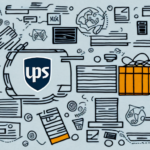Understanding How UPS Shipping Rates Affect Delivery Times
Shipping rates are a crucial factor to consider when planning your delivery strategy, especially if you use UPS. UPS offers a variety of shipping options, each with its own cost and delivery time frame. The cost to ship your package will affect the speed and efficiency of delivery, which can ultimately impact your customer satisfaction. In this article, we'll explore the different factors that affect UPS shipping rates and how they impact delivery times, as well as provide practical tips to help you estimate and optimize shipping costs for your business.
The Importance of Knowing UPS Shipping Rates for Effective Delivery Strategies
Understanding UPS shipping rates is essential to develop accurate pricing models and determine the most cost-effective shipping strategies for your business. Shipping rates vary based on several factors, including package weight, destination, delivery time frame, and type of service. By understanding these variables, you can choose the most appropriate shipping options to meet your customers' needs while minimizing costs.
It is also important to keep in mind that UPS shipping rates are subject to change, and it is crucial to stay up-to-date with any updates or modifications. This can be done by regularly checking the UPS website or subscribing to their email notifications. Additionally, taking advantage of UPS's online tools and resources, such as their shipping calculator and tracking system, can help streamline the shipping process and improve overall efficiency.
How UPS Shipping Rates Vary Based on Different Factors
Several factors determine UPS shipping rates. These include:
- Package Weight: The heavier your package, the higher the shipping cost.
- Package Size: Oversized packages and those requiring special handling incur additional charges.
- Distance: Longer distances between the origin and destination increase shipping costs.
- Service Type: Expedited services are more expensive than standard ground delivery.
- Destination Location: Remote or hard-to-reach areas may have additional fees.
- Seasonality: During peak seasons like holidays, shipping rates may rise due to high demand.
Understanding these factors can help you anticipate changes in shipping costs and adjust your strategies accordingly.
How to Calculate UPS Shipping Rates and Choose the Right Options for Your Business
Calculating UPS shipping rates is straightforward using the UPS online shipping calculator. By entering the package dimensions, weight, and destination, you can obtain an estimated cost and delivery time frame. This information allows you to select the most appropriate shipping service that aligns with your budget and delivery requirements. Typically, standard ground shipping is the most cost-effective option, while expedited delivery services offer faster delivery at a higher cost.
The Impact of UPS Shipping Rates on Delivery Timeframes
UPS shipping rates are closely linked to delivery timeframes. More expensive shipping options, such as expedited services, offer shorter delivery times, whereas standard ground delivery is more affordable but takes longer. Balancing cost with delivery speed is essential to meet customer expectations and maintain satisfaction.
Additionally, the destination's distance can affect delivery times. For instance, shipping a package from New York to California may take longer than shipping within closer states like New York to New Jersey. Factoring in distance ensures that you select a shipping option that guarantees timely delivery.
UPS also offers additional services that can influence both cost and delivery time, including:
- Signature Confirmation: Ensures the package is received by the intended recipient.
- Insurance: Protects against loss or damage during transit.
- Package Tracking: Allows both sender and recipient to monitor the shipment's progress.
While these services enhance security and transparency, they can also increase shipping costs or affect delivery times. It's important to evaluate the necessity of each service based on your business needs.
How to Optimize Your Shipping Strategy Based on UPS Shipping Rates and Delivery Times
Optimizing your shipping strategy involves carefully considering UPS shipping rates alongside the desired delivery timeframe to align with your business objectives. Key strategies include:
- Customer Shipping Options: Offer choices such as free shipping for orders over a certain amount to boost customer satisfaction and increase average order value.
- Efficient Packaging: Use appropriate packaging materials and methods to reduce size and weight, thereby lowering shipping costs and minimizing product damage.
- Eco-Friendly Packaging: Select sustainable packaging options to appeal to environmentally conscious consumers and reduce environmental impact.
- Multiple Shipping Options: Provide various shipping methods, including expedited and international shipping, to cater to a broader customer base and enhance sales potential.
By adopting a holistic approach to your shipping strategy, you can meet customer expectations, reduce operational costs, and drive business growth.
The Relationship between UPS Shipping Rates and Package Weight, Size, and Destination
Package weight, size, and destination significantly influence UPS shipping rates. Heavier and larger packages destined for distant or remote locations will incur higher shipping costs. UPS offers several tools to help optimize packaging and minimize costs, such as:
- Efficient Packaging Materials: Utilize materials that provide protection without excessive size or weight.
- Consolidation: Combine multiple packages into a single shipment to maximize volume and reduce overall shipping expenses.
The type of service selected also affects shipping rates. UPS provides various options, including ground, air, and international services, each with distinct pricing structures. Additionally, the value of the package plays a role in rate calculations; high-value items may require additional insurance to safeguard against loss or damage during transit.
Tips for Negotiating Better UPS Shipping Rates and Discounts for Your Business
UPS shipping costs can accumulate, especially for businesses with high shipping volumes. Negotiating better rates with UPS can significantly reduce these expenses. Here are some strategies:
- Demonstrate Business Value: Highlight your shipping volume and potential for growth to leverage better rates.
- Consolidate Shipments: Group multiple shipments into fewer packages to qualify for volume discounts.
- Partner with Other Businesses: Collaborate with similar businesses to negotiate group shipping rates.
- Explore Alternative Shipping Services: Assess different UPS services to find cost-effective options that meet your delivery requirements.
Remember, negotiating shipping rates is an ongoing process. As your business grows and shipping needs evolve, regularly review and renegotiate your shipping agreements to ensure you continue receiving the best possible rates.
How to Use Technology to Streamline Your Shipping Process with Accurate UPS Shipping Rates and Tracking Information
Leveraging technology can significantly enhance your shipping process by automating manual tasks and improving accuracy. Consider utilizing:
- Shipping Software Applications: Integrate with UPS's platform to simplify tasks such as label printing, tracking shipments, and estimating shipping costs. These tools can reduce errors and save time.
- Automated Tracking Systems: Provide real-time updates to customers, enhancing transparency and satisfaction.
- Data Analytics: Analyze shipping data to identify trends, optimize routes, and make informed decisions about shipping strategies.
By implementing these technological solutions, you can streamline operations, reduce costs, and improve the overall efficiency of your shipping process.
Common Mistakes to Avoid When Estimating UPS Shipping Rates and Delivery Times
Accurate estimation of UPS shipping rates is vital for competitive pricing and customer satisfaction. Avoid these common mistakes:
- Inaccurate Package Measurements: Always double-check the dimensions and weight of your packages to ensure precise rate calculations.
- Choosing the Wrong Shipping Option: Select the shipping service that best fits your delivery timeframe and budget. Misalignment can lead to unnecessary costs or delayed deliveries.
- Overlooking Customs Fees: For international shipments, account for customs fees and duties to prevent unexpected costs and delivery delays.
- Poor Packaging: Inadequate packaging can result in damaged goods, leading to additional costs and dissatisfied customers.
Additionally, be aware that UPS delivery times can vary based on destination and selected service. For example, UPS Ground typically takes 1-5 business days, while UPS Next Day Air promises delivery by the next business day. Factor in potential delays, such as weather conditions or holidays, to ensure timely deliveries.
Understanding the Role of Customs and Duties in International UPS Shipments and Their Effect on Delivery Times
When shipping internationally with UPS, customs and duty fees can significantly impact both cost and delivery times. These fees vary based on the destination country's regulations and tariffs. Failing to account for these fees can result in unexpected expenses and shipment delays. To mitigate these issues:
- Research Destination Regulations: Understand the specific customs requirements and duties for each country you ship to.
- Accurate Documentation: Ensure all shipping documents are correctly filled out to expedite customs clearance.
- Pre-Payment of Duties: Consider programs that allow you to pre-pay customs fees to reduce delivery times.
By proactively managing customs and duties, you can enhance the efficiency of your international shipping operations and provide a better experience for your customers.
The Future of UPS Shipping Rates in a Changing E-commerce Landscape
The e-commerce boom has driven significant changes in shipping demands, prompting UPS to adapt its services accordingly. Future trends that may influence UPS shipping rates include:
- Increased Demand for Fast Shipping: As consumers expect quicker delivery times, UPS may expand its expedited services, potentially affecting rates.
- Adoption of New Technologies: Innovations like drone delivery and automation could streamline operations and influence pricing structures.
- Sustainability Initiatives: Emphasizing eco-friendly shipping options may lead to new services that balance cost with environmental impact.
- Global Expansion: As e-commerce becomes more global, UPS may enhance its international shipping services, impacting rates based on new routes and services.
Staying informed about these trends will help businesses anticipate changes in UPS shipping rates and adjust their strategies to remain competitive in the evolving e-commerce landscape.
Conclusion
UPS shipping rates and delivery times are crucial factors in planning an effective delivery strategy that meets your customers' needs while remaining cost-effective. By utilizing the tips and information provided in this article, you can optimize your shipping costs, calculate shipping rates more accurately, and streamline your shipping process using technology. Developing an effective shipping strategy not only enhances customer satisfaction and retention but also contributes to the profitable growth of your business.




















